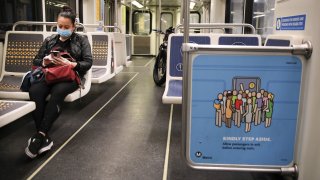
Hoping to identify improvements that could better tailor transit systems to meet the needs of women, the Los Angeles Department of Transportation released a study Friday on mobility challenges women face, such as the need to take more complex trips, often accompanied by small children.
According to "Changing Lanes: A Gender Equity Transportation Study," women are less likely to have a driver's license and access to a vehicle than men. At the same time, they're more likely to take trips that require multiple stops because they are often responsible for a larger share of household and childcare-related duties. They're also more likely to be carrying strollers and shopping bags, as well as be accompanied by children.
The study comes at a time that Los Angeles' transportation agencies are led by women: LADOT General Manager Seleta Reynolds, Metro CEO Stephanie Wiggins and Metro Board of Supervisors Chair and L.A. County Supervisor Hilda Solis.
"I could not have imagined this day back in 2014 when I started my job, I was one of only a handful of women transportation leaders around this country," Reynolds said.
Get Southern California news, weather forecasts and entertainment stories to your inbox. Sign up for NBC LA newsletters.
She said transit systems were not designed with women and mothers in mind.
"If you have a nine-to-five white collar job, the system works for you. But it doesn't work for you if you have small children with you, and bags to carry and if you don't have the funds available to access all the transit options that wealthier folks have," Reynolds said.
According to the study, even transit infrastructure is designed using men's bodies instead of women, which makes grab bars, handles, ramps, curbs and seats less effective for women.
The study focused on women in Sun Valley, Watts and Sawtelle, which were chosen to represent different demographics in Los Angeles. It found that before the pandemic, women took more transit trips than men in Sun Valley, but men took more trips than women in Watts and Sawtelle.
"More than half the women on the (Metro) system have children. That means women may have strollers, diaper bags and other belongings with them that usually makes travel even more difficult for them," Solis said.
The study follows Metro's "Understanding How Women Travel" study, which was released in 2019.
"Some of the women we interviewed in our study have major concerns about safety. Some even said they intentionally wore sneakers on transit just so they could be able to make a quick getaway in case they were assaulted. Women experience transportation differently than men," Solis said.
LADOT's study also found that women face safety concerns, as well as other barriers for most modes of transportation, including poor walking environments, lower access to driver's licenses, high costs and transit inefficiencies like long travel times and infrequent service.
The study listed goals for LADOT going forward, including:
- closing the data gap and informing transportation infrastructure, service and program decisions with data gathered on the challenges faced by women, low-income people and people of color;
- tailoring transportation solutions to neighborhood density and bringing resources to communities that are low-income and low-density to reduce travel burdens for women;
- designing a safe, convenient and comfortable transportation environment by increasing street lighting and shade covers, improving street furniture, increasing the amount of crosswalks and placing bus stops in active business zones;
- improving efficiency of care-related and recreation travel without a car;
- aligning transit service with how and when women travel, including through a partnership between Metro and DASH to make trip-chaining more efficient and affordable; and
- developing new service options to support women, including pilot models of a nonprofit community-based van or care-share program and a dial-a-ride service.
The study also recommends implementing programs to improve women's safety when traveling. Ideas include:
- hiring local women to serve as ambassadors and provide a safety presence in public spaces;
- partnering with Metro to implement a courtesy-stop program at night so riders can exit buses closer to their destinations;
- partnering with schools to create a curriculum about preventing gender-based harassment and violence; and
- training bus drivers to respond to sexual harassment.
"In a world that has been shaped by men, from the workplace to the home, when women are in leadership positions, we create a different perspective," Los Angeles City Council President Nury Martinez said at a news conference Friday to announce the study.
"That is why the Department of Transportation's gender equity and transportation study is so important, because in the neighborhoods that I represent, walking to your destination is not always an option for you. They must rely on public transportation," she added.



